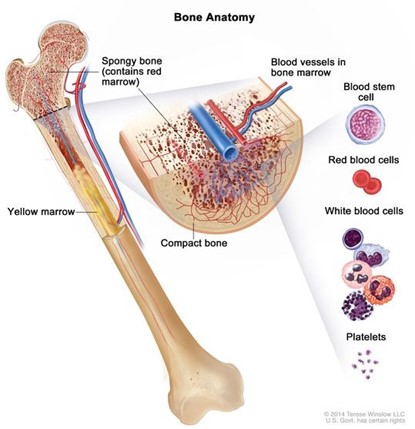What resides in the medullary cavity of long bones?
Spongy bone only.
Compact bone only.
None of these.
Bone marrow.
The Correct Answer is D
Bone marrow is the soft, spongy tissue that fills the medullary cavity of long bones.
Bone marrow contains hematopoietic stem cells that produce blood cells, as well as fat cells and other supportive cells.

Choice A is incorrect because spongy bone is not the tissue that fills the medullary cavity, but the type of bone tissue that surrounds it.
Spongy bone has a porous structure that provides strength and flexibility to the bone.
Choice B is incorrect because compact bone is not the tissue that fills the medullary cavity, but the type of bone tissue that forms the outer wall of the diaphysis.
Compact bone has a dense and hard structure that provides protection and support to the bone.
Choice C is incorrect because none of these is not a valid answer.
The medullary cavity of long bones does contain a specific type of tissue, which is bone marrow.
Nursing Test Bank
Naxlex Comprehensive Predictor Exams
Related Questions
Correct Answer is ["External rotation of the shoulder joint"]
Explanation
External shoulder rotation is the movement of the humerus bone away from the centerline of the body, rotating the arm so that the palm faces away from the body.
This movement is achieved by the contraction of the external rotator muscles of the shoulder, which include the infraspinatus, teres minor, and posterior fibers of the deltoid muscle.
The joint involved in external shoulder rotation is the glenohumeral joint, also known as the shoulder joint.
The shoulder joint is a ball-and-socket joint formed by the articulation between the head of the humerus bone and the glenoid cavity of the scapula bone.
This joint allows for a range of movements, including:
1. Internal shoulder rotation: This is the opposite movement of external rotation, in which the humerus bone rotates inward toward the centerline of the body, with the palm facing inward.
2. Shoulder flexion: This is the movement of the humerus bone forward and upward, bringing the arm closer to the body's front.
3. Shoulder extension: This is the movement of the humerus bone backward and downward, moving the arm away from the body's front.
4. Shoulder abduction: This is the movement of the humerus bone away from the body's midline, raising the arm out to the side.
5. Shoulder adduction: This is the movement of the humerus bone toward the body's midline, bringing the arm back down to the side of the body.
6. Shoulder horizontal abduction: This is the movement of the humerus bone away from the body's midline at shoulder height.
7. Shoulder horizontal adduction: This is the movement of the humerus bone toward the body's midline at shoulder height.
All of these movements of the glenohumeral joint are important for many daily activities, including reaching, throwing, pushing, pulling, and lifting.
Correct Answer is D
Explanation
A cartilaginous joint is a joint where the bones are united by cartilage.
A hyaline cartilage joint is a type of cartilaginous joint where the bones are joined by hyaline cartilage.
An example of a hyaline cartilage joint is the first sternocostal joint that unites the first rib to the sternum.
Choice A is incorrect because hyaline cartilage joints are not present in the maxilla.
The maxilla is a single bone that forms the upper jaw and palate. Choice B is incorrect because none is not a valid answer.
Choice C is incorrect because fibrous cartilage joints are not present in the skull. The skull bones are joined by fibrous joints called sutures.
Whether you are a student looking to ace your exams or a practicing nurse seeking to enhance your expertise , our nursing education contents will empower you with the confidence and competence to make a difference in the lives of patients and become a respected leader in the healthcare field.
Visit Naxlex, invest in your future and unlock endless possibilities with our unparalleled nursing education contents today
Report Wrong Answer on the Current Question
Do you disagree with the answer? If yes, what is your expected answer? Explain.
Kindly be descriptive with the issue you are facing.
